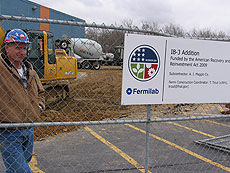ARRA funds construction for industrial building addition
 |
| Subcontractor Fred Huckstorf stands in front of his excavator at the IB3A construction site. |
On a recent afternoon, Ken Kleiner slogged through deep mud the color and consistency of peanut-butter pudding. It was a cloudy day, and only about 40 degrees outside.
"You try to capitalize on days like today when it's nice out," said Kleiner, A.J. Maggio Co.'s on-site supervisor for the new IB3A (Industrial Building 3 Addition). He pointed out men pouring concrete and a huge excavator digging a gaping hole in the mud. "We started two weeks ago, and we're right on track."
Using funds from the American Recovery and Reinvestment Act, Fermilab awarded the $2.7 million construction contract to A.J. Maggio Co., a firm based in Mt. Prospect, Illinois. When complete the addition to the two-story building will run along the southern length of IB3, and will provide more than 13,000 square feet of laboratory and office space.
IB3 has become so overcrowded, said Romesh Sood, Fermilab's IB3A project director, that it's hindering research. "We have to shut down some R&D activities to allow others," he said. "It's a juggling act."
IB3A will be dedicated to advancing R&D for superconducting radio-frequency cavities and for materials used in superconducting magnets-both areas that have potential applications in energy and medicine. According to Giorgio Apollinari, head of Fermilab's Technical Division, the new space will provide the kind of synergy needed for cutting-edge research.
"Once you have both IB3 and IB3A operational, you can have all the right people in the same place, exchanging ideas and know-how, but without getting in each other's way," he said.
In the meantime, the project is putting people to work. It created man-hours for seven full-time jobs. Ken Kleiner says that may not sound like a lot, but it all adds up for the subcontractors hired to do the work.
"Instead of working three days a week, a guy might be working five days a week," Kleiner said. "So I guess the Recovery Act is working."
-- Andrea Mustain
|